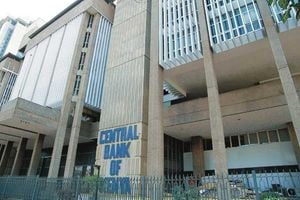
President William Ruto addresses journalists at KICC, Nairobi flanked by his deputy Rigathi Gachagua, Azimio leader Raila Odinga and other national leaders on July 9, 2024.
One way of understanding the management of public affairs is to study the behavior of various actors.
One class of actors is studied regularly. Politicians. But a universal theory explaining their conduct remains elusive. But here are some studies to liven up your weekend conversations.
Such telling titles. “Why leaders lie”, “the political economy of unfinished development projects”, “the value of democracy, evidence from road building in Kenya” and, “what is unity – is it possible, is it good?”
Calls for unity are frequent in our republic. Many a politician proclaim that unity is there highest priority - bringing people together, so that we move forward. Political presentation is vague, so, what is meant by these calls, and for what purposes is unity sought?
For starters, even as they make these calls, politicians will be shouting themselves hoarse over some real or imaginary enemy.
The same enemy who they shall shortly embrace in brotherly love, for the sake of our beloved nation! In the nineties, Moi’s government made these calls in a bid to retain power, while the opposition made similar calls, in a bid to remove them. You can see why. Moi was winning because opposition was splitting the majority vote.
Defining unity is harder than it looks. Unity is seen as the opposite of divided. One view sees unity as being ordered in pursuit of a common goal. Some use a tree analogy. Unity does not have to mean sameness or oneness. A big tree has many branches, of varying sizes.
They don’t fit together neatly as say parts of a machine, but they have a certain coherence that makes the tree what it is.
As you assign meaning (or lack thereof) of the calls for unity by Kenyan politicians, consider the ways in which citizens are divided. One regular “divide” has been around tribe.
Our tribe versus theirs. Not that proof was needed, but the 1,300 deaths from the 2007/8 political violence is a stark reminder on just how disastrous this divide can be. Fortunately, the recent GenZ revolution as disabused us of this divide.
A related, but even more artificial divide, is the region. Coast region, Mt. Kenya, North Eastern, Lower Eastern and so on.
For politicians interested in the national scene, the bigger the region the better. And of course even within the regions, politicians are preaching unity within counties.
In this narrative the purpose of unity is to create leverage for national bargaining, based on numerical strength (and therefore votes). The more we are, the more our weight in national government and with it, development goodies and jobs in government.
To be fair, resource allocation is a political process, so numbers matter. But it is also rational process. White elephants are projects where rationality has failed, and execution is mainly on political grounds.
The constituency markets that we build during an economic stimulus in Kibaki II are a good example.
Announced by Uhuru, then deputy prime minister and finance minister, the idea received thunderous applause by members of parliament. Each MP would identify government land on which to build a market.
Many locations turned out to be inappropriate, so some markets remain unused fourteen years later! Is not the ultimate con then, if unity is simply to help us bargain for projects that are not fit for purpose or which may never be completed?
In 2021, disclosures in parliament showed that the value of stalled projects was about 9 trillion shillings, then equivalent to the GDP.
Three years later, the Parliamentary Budget office reported that government was handling 4,500 stalled projects in nine sectors in 2024. It had spent 3.9 trillion shillings on them and needed another 4.18 trillion shillings to complete.
You would think that governments have strong incentives to complete projects. After all projects are politically popular, often visible and are perfect for credit claiming.
In fact some politicians put up bill boards with their photos to ensure you understand that they are responsible for the project. On the surface, there are strong political incentives to deliver. Why are so many projects incomplete?
I offer three plausible explanations. First, corruption. The project cannot get finished because someone stole the money.
Kimwarer and Arror dams come to mind. Second, politicians may leave projects unfinished because it is strategically useful for their re-election. Third, collective choice can lead to inconsistent results.
The timing of our preferences (when we want something) is different so therefore, are, our choices.
In this theory, our politicians preach unity for purposes of bargaining for, and launching projects.
That is how they prove they are working. The aim is generating positive media mentions of themselves launching various projects and programs. Flag offs are popular.
Be it a consignment of medicines for distribution to the health facilities, food relief or subsidized fertilizer, a photo-op, and acres of social media, is a must. Mheshimiwa must show how hard working she is.
The politician then moves to the next village, town or ward. The citizens there too want a dispensary, road, or school.
So she repeats the same process. Launch, photo-op, post on social media, then proceed. Completing the projects, ensuring impacts, such as quality education or health or jobs is never a consideration.
Calls for unity are a con. If still in doubt, ponder this. A recent study of 14,000 small development projects by local governments in Ghana found that thirty percent were never completed, despite consuming one fifth of the budgets! Sound familiar?
@NdirituMuriithi, an economist is partner at Ecocapp Capital









